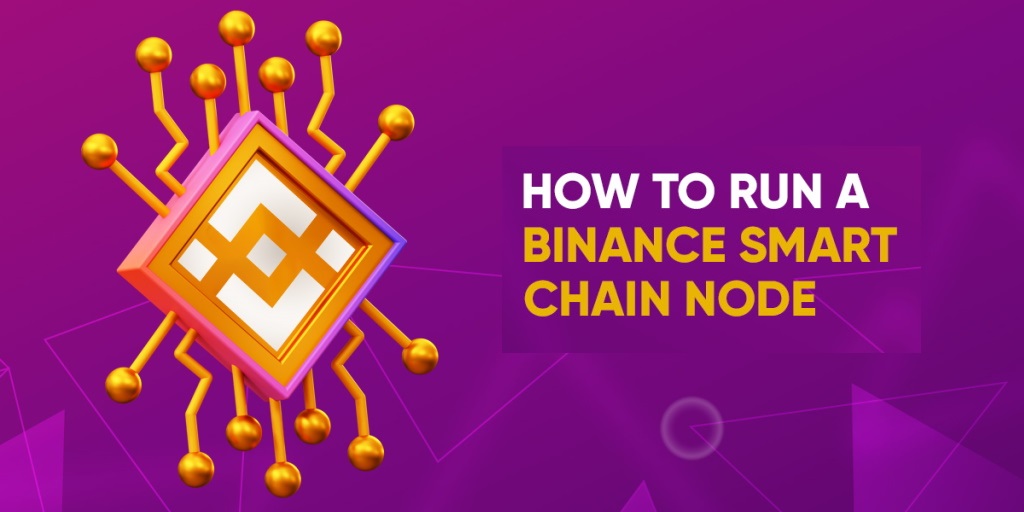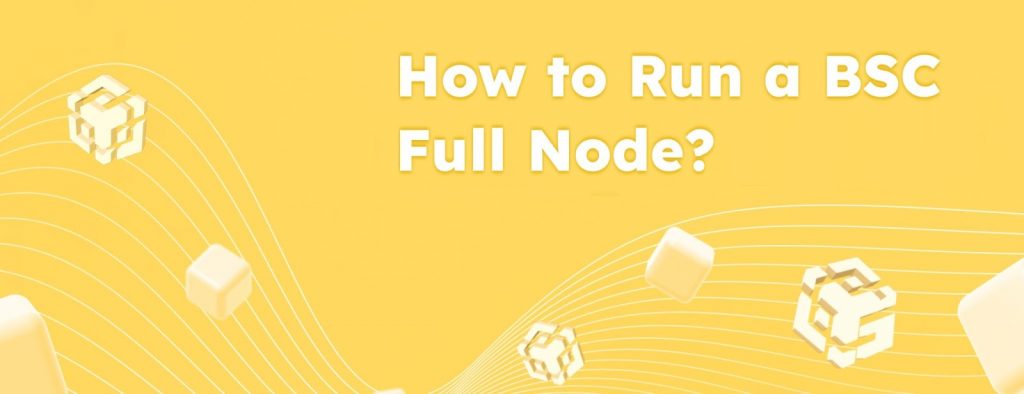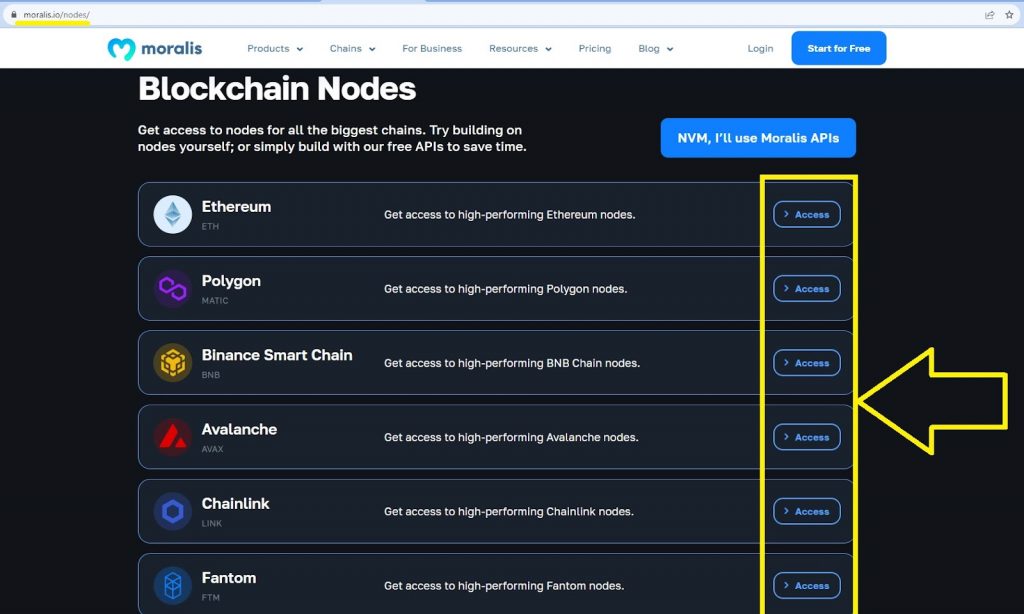BNB Smart Chain nodes are essential components in the BNB Smart Chain (BSC) ecosystem. In fact, without them, the network would not be able to operate correctly. As you can imagine, anyone wanting to develop dapps on BNB Smart Chain must understand what a BSC node is, how it works, and how to run one. So, if you’re a dev who wants to get a solid understanding of nodes on BNB Smart Chain and start developing applications on BSC, then this full BSC node guide will be highly beneficial!

Overview
In today’s article, we’ll cover the basics of BSC nodes and the BSC network. We’ll also explain how a BSC node works. Now, if you’re already familiar with the basics, jump to the “How to Run a BSC Node” section to explore two methods for running a BNB Smart Chain node. What’s more, you’ll also learn how to create a dapp without running a node. Lastly, we’ll highlight a popular BSC node use case and introduce Moralis as a shortcut for dapp development.

What is a BSC Node?
A BSC node is a fundamental component within the BNB Smart Chain (BSC) network. Furthermore, BSC nodes play a crucial role at the core of this programmable blockchain network. After all, they are the components that help maintain the network’s integrity and functionality.
Essentially, a BSC node is a software application, and by running on a server or local computer, this software participates in the BSC network. Its job is to validate transactions, process smart contracts, and store a copy of the BSC blockchain ledger. Each node plays a vital role; however, the true power lies in nodes working together. After all, this network of BSC nodes joins forces to collectively ensure the security, transparency, and decentralization of the BSC network.
What is BSC and BNB Smart Chain?
BSC now stands for BNB Smart Chain. However, before February 2022, BSC stood for Binance Smart Chain. In either case, the abbreviation points to the same chain. It’s just a question of semantics!
As you may know, the Binance blockchain (officially called Binance Chain) launched back in April 2019. At the time, the chain had the purpose of hosting the BNB token and facilitating fast decentralized trading. The BNB token was initially born on Ethereum back in 2017 and transitioned to Binance Chain in 2019. And it wasn’t until September 2020 that the Binance organization/community launched its own programmable blockchain, capable of hosting smart contracts. That is the chain that devs use to create tokens and dapps. At the time of launch, this programmable network was called Binance Smart Chain.
However, in February 2022, the Binance Foundation decided to rename/rebrand their two chains. This rebranding created an umbrella name – BNB Chain – for both the governance/trading chains and the programmable chain.
The 2022 “Build and Build” rebranding also renamed Binance Chain into BNB Beacon Chain and Binance Smart Chain into BNB Smart Chain. It also changed the chain’s native token name from Binance Coin to “Build and Build” (BNB). However, BNB was the token’s initial symbol/ticker anyway.
This quick summary should help you clarify things for good:
- The network that serves governance and trading/staking purposes: BNB Beacon Chain (formerly Binance Chain).
- The network that serves as a programmable blockchain (EVM-compatible, consensus layer): BNB Smart Chain (BSC) (formerly Binance Smart Chain).
- BNB Beacon Chain + BNB Smart Chain (BSC) = BNB Chain.

How Does a BSC Node Work?
A Binance Smart Chain (BSC) node works as a crucial component of the BSC network by participating in various processes to maintain the blockchain’s functionality and integrity:
- Blockchain Data Storage: A BSC node stores a complete copy of the BSC blockchain ledger. This ledger contains records of all transactions, smart contracts, and account balances that have occurred on the network. The node continually updates this ledger as new transactions come in, ensuring it has the most up-to-date information.
- Transaction Validation: Whenever users initiate transactions on the BSC network, they get broadcasted to multiple nodes. BSC nodes verify the validity of the transaction by checking various factors. For example, the nodes check if the transaction sender has sufficient funds and whether the transaction adheres to the network’s rules and consensus mechanisms.
- Consensus Participation: BSC uses a proof-of-stake (PoS) consensus mechanism. So, BSC nodes, specifically validator nodes, participate in this consensus process. They propose and confirm new blocks of transactions. To run a validator node, users need to stake BNB as collateral. The network chooses validators for transactions based on their BNB stake and reputation.
- Smart Contract Execution: BSC nodes have the capability to execute smart contracts. When a smart contract is invoked, nodes process the contract’s code and execute the predefined actions encoded within it.
- Network Communication: BSC nodes communicate with each other to propagate transactions, share blocks, and reach consensus.
- API Services: BSC nodes offer APIs that allow developers and decentralized applications (dapps) to interact with the blockchain programmatically.
- Block Production: Validator nodes take turns producing new blocks (batches of confirmed transactions) in the BSC blockchain.
- Decentralization: By running multiple nodes across different geographic locations and operated by various entities, BSC nodes contribute to the decentralization of the network.

How to Run a BSC Node
When it comes to running a BSC node, you have several options. One approach requires you to download the latest version of the blockchain and run the required software. In certain situations, taking this path makes sense. However, for the majority of developers who just want to create dapps or launch tokens on top of the BSC network, there’s a much simpler path.

You can learn more about each of the two methods of running a BSC node in the following subsections.
Running a BSC RPC Node the Hard Way
In case you plan on taking on a project that requires you to run a full BSC node, make sure to visit the above-outlined documentation page. This is where you’ll learn all you need to know about the hardware and software prerequisites. On that site, you’ll also find out about the amount of BNB tokens you need to execute that mission.
Furthermore, the BNB Chain documentation also highlights the following steps required to run a BCS node:
- Setting Up the Environment
- Compiling the Code
- Configuring the Node
- Initializing the Blockchain
- Running the Node
- Becoming a Validator (Optional)
- Monitoring and Maintenance
- Security Measures
- Community Engagement
- Backup and Recovery
Before embarking upon the above steps, it’s important to note that running a BSC node is a significant commitment. It requires technical expertise and resources to set it up and to run it smoothly. As such, unless your project demands you to run your own node, you should either focus on using BSC RPC node providers or simply use the Moralis API.
Running a BSC RPC Node the Easy Way
If you decide to deploy your smart contracts, you will need access to a BCS node. However, this doesn’t mean you need to take the difficult approach outlined in the above section. Instead, you can use a reliable BSC RPC node provider.
There are many providers out there, and it can be quite challenging to sift through all the options. As such, we created a curated list of reliable node providers. This list allows you to run a BSC RPC node the easy way and enables you to do so for other reputable chains. So, if you need a BSC node, Ethereum node, or any other EVM-compatible node, simply follow the steps below:
- Visit the Moralis Nodes page. Under the “Blockchain Nodes” title, you’ll find an extensive list of RPC nodes for all the leading Web3 chains.
- Decide which chain you want to focus on and hit the “Access” button next to that chain. For instance, if you are in need of a BCS RPC node, click on the “Access” button next to “Binance Smart Chain”:

- By hitting the “Access” button, you’ll be redirected to a reliable RPC node provider. To use the provider’s nodes, you will want to complete the setup process, starting with completing a signup form.
Start Developing on BSC without Running Nodes
As pointed out previously, there are Web3 projects that will require you to choose one of the above two outlined options for running a node. If you’re not certain whether you need to run your own node or not, use our support chat. Simply click on the Moralis logo in the bottom-right corner:

However, generally speaking, you can create all sorts of killer dapps without running your BSC node or any other RPC node. The “NVM, I’ll use Moralis APIs” button on the Moralis Nodes page indicates this as well.
Using powerful Moralis Web3 APIs lets you skip running nodes altogether! All in all, taking this practical shortcut saves you a lot of time and development resources!
So, if you want to start developing on BSC or any other leading EVM-compatible chain without running nodes, simply hit the “NVM” button or use the Moralis homepage’s top menu to select the APIs you are primarily interested in. That’s the best way to explore this amazing solution for dapp developers. That said, we’ll cover the gist of the Moralis API fleet in the section below.
BSC Node Use Cases
There are all sorts of use cases for RPC nodes. However, some of the primary reasons users decide to take that path are to become network validators or acquire on-chain data. Those are the most common BCS node use cases.
However, most Web3 developers just want to build cool and useful dapps, which doesn’t necessarily require them to run nodes. Still, in case you plan on deploying a lot of smart contracts, using a reliable RPC node is a smart option.
These are some of the most popular types of dapps you can create with Moralis APIs:
- Blockchain Explorers
- Live Price Feed Sites
- Portfolio Dapps
- Web3 Wallets
- NFT Marketplaces
- NFT Authentication Sites
Creating Killer Dapps the Easy Way with Moralis Money
If you covered the above sections, you know that the simplest way to start building dapps doesn’t require you to run a BSC RPC node or any other node. Instead, all you need is Moralis’ API.
Even if your project requires you to run your own node, reliable Web3 APIs are still must-haves. After all, you want to focus on the special features and UI of your dapp instead of wasting time and resources on reinventing the wheel.
Thus, make sure to get acquainted with the ultimate Web3 APIs from Moralis:
- Market Data API – It makes accessing information regarding trending NFT collections, top ERC-20 tokens, NFT airdrops, and much more super easy.
- NFT API – Allows you to access enriched metadata, real-time NFT transfer data, NFT ownership data, and much more and create the next big NFT-focused dapp the easy way.
- Price API – With the most complete crypto price API on the market, you can get the prices of all cryptocurrencies.
- Wallet API – Your definitive solution for integrating wallet functionalities into your Web3 dapps.
- Token API – It enables you to add real-time token prices, wallet balances, transfers, and liquidity to your dapp without breaking a sweat.
In addition, Moralis offers its powerful Transaction API, Balance API, DeFi API, Events API, Block API, Resolve API, EVM API, and APIs for other supported chains. So, if you aim to target the BSC chain, Moralis’ BNB Chain API is what you need!

Furthermore, the Moralis product fleet also entails the Streams API and Auth API. The former empowers you to cover real-time, on-chain notifications. As for the latter, it allows you to cover your dapp’s Web3 authentication needs with a single snippet of code.
Summary: Full BSC Node Guide – How to Run BNB Smart Chain Nodes
In today’s article, you had an opportunity to learn the basics of a BSC node. As such, you now know that BSC nodes form the foundation of the BSC network. You also learned that BSC stands for BNB Smart Chain. Plus, you finally got to clarify the whole confusion regarding the 2022 “Build and Build” rebranding.
At this point, you also understand how BSC nodes work and their core tasks. Nonetheless, you also learned how to run a BSC node both the hard and the easy way. So, you now know that if your Web3-developing needs call for a BSC RPC node, you can cover that need by visiting the Moralis Nodes page.
However, you also learned that you can build all sorts of dapp without running a blockchain node. Thanks to Moralis APIs, you can do so fast and with resources to spare. As such, you get to double down on the unique features of your dapp and its user-friendly interface.
So, start developing with Moralis by signing up for free today!
And if you plan on building your dapps on BSC, don’t forget to properly test their features on the BSC testnet. To that end, use a reliable BNB faucet to get some test BNB.
Happy BUIDLing!
Read More: moralis.io








 Bitcoin
Bitcoin  Ethereum
Ethereum  Tether
Tether  XRP
XRP  Solana
Solana  USDC
USDC  Dogecoin
Dogecoin  TRON
TRON  Cardano
Cardano  Lido Staked Ether
Lido Staked Ether  Wrapped Bitcoin
Wrapped Bitcoin  Hyperliquid
Hyperliquid  Sui
Sui  Wrapped stETH
Wrapped stETH  Chainlink
Chainlink  Avalanche
Avalanche  Stellar
Stellar  Toncoin
Toncoin  Bitcoin Cash
Bitcoin Cash  LEO Token
LEO Token  Shiba Inu
Shiba Inu  Hedera
Hedera  USDS
USDS  WETH
WETH  Litecoin
Litecoin  Monero
Monero  Wrapped eETH
Wrapped eETH  Polkadot
Polkadot  Binance Bridged USDT (BNB Smart Chain)
Binance Bridged USDT (BNB Smart Chain)  Ethena USDe
Ethena USDe  Bitget Token
Bitget Token  Pepe
Pepe  Pi Network
Pi Network  Coinbase Wrapped BTC
Coinbase Wrapped BTC  WhiteBIT Coin
WhiteBIT Coin  Dai
Dai  Aave
Aave  Uniswap
Uniswap  Bittensor
Bittensor  Ethena Staked USDe
Ethena Staked USDe  Cronos
Cronos  Aptos
Aptos  OKB
OKB  NEAR Protocol
NEAR Protocol  BlackRock USD Institutional Digital Liquidity Fund
BlackRock USD Institutional Digital Liquidity Fund  Jito Staked SOL
Jito Staked SOL  Internet Computer
Internet Computer  Ondo
Ondo  Ethereum Classic
Ethereum Classic